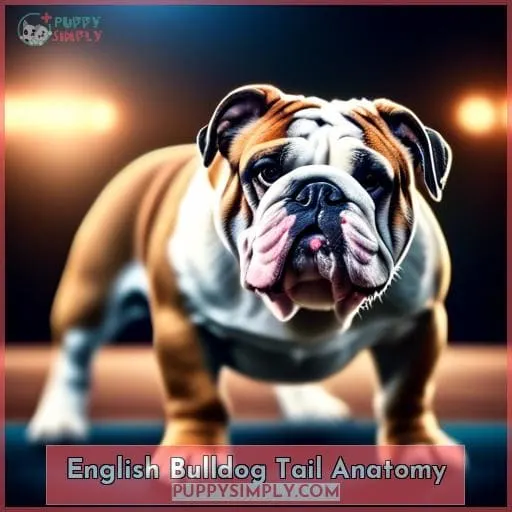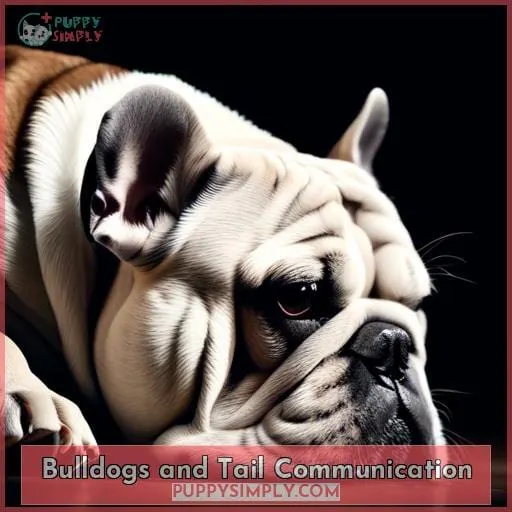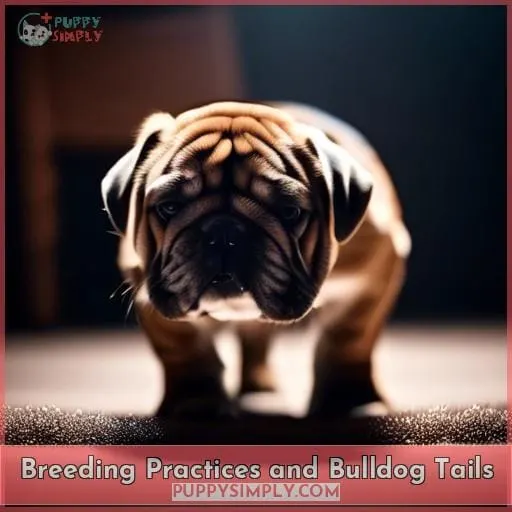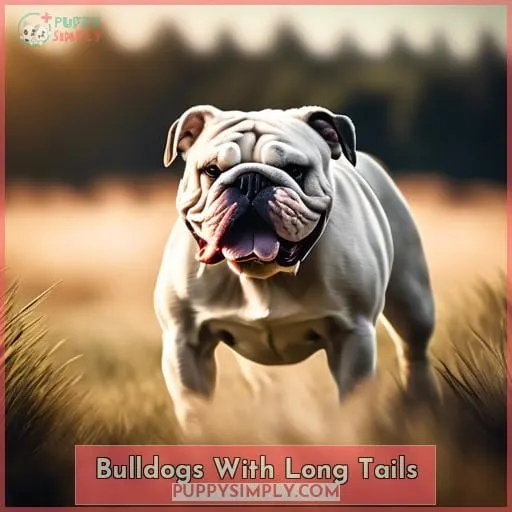This site is supported by our readers. We may earn a commission, at no cost to you, if you purchase through links.
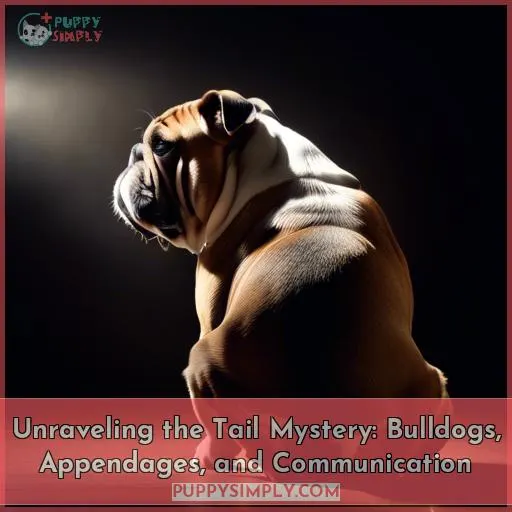 Imagine a four-legged friend with a wrinkly face, a muscular body, and a distinctive tail that can be short and straight, curly and like a twisted screw, or even long and flowing.
Imagine a four-legged friend with a wrinkly face, a muscular body, and a distinctive tail that can be short and straight, curly and like a twisted screw, or even long and flowing.
Meet the Bulldog, a breed shrouded in tail mystery.
Do Bulldogs have tails? If so, what types of tails do they have? How do they use their tails to communicate?
Join us as we embark on a journey to unravel the tail mystery of Bulldogs, delving into their anatomy, communication methods, and the controversies surrounding tail docking.
Table Of Contents
- Key Takeaways
- English Bulldog Tail Anatomy
- Treating and Preventing Bulldog Tail Problems
- The Controversy of Tail Docking
- Bulldogs and Tail Communication
- Tail Pockets in Bulldogs
- Breeding Practices and Bulldog Tails
- Bulldogs With Long Tails
- Caring for Bulldogs With Tails
- Understanding Dog Body Language
- Frequently Asked Questions (FAQs)
- How do corkscrew tails impact a bulldog’s ability to balance?
- Are there any specific activities that should be avoided to prevent injury to a bulldog’s tail?
- What are the long-term health implications of having a corkscrew tail for a bulldog?
- How does a bulldog’s tail help it communicate with other dogs?
- What is the role of the tail in a bulldog’s overall body language?
- Conclusion
Key Takeaways
- Bulldogs typically have short tails that can be straight, curly, or screw-tails.
- Screw-tails can cause skin infections and spinal column malformations, requiring antibiotics or even amputation.
- Tail docking, once common to protect Bulldogs from farm work injuries, is now considered an unnecessary practice due to ethical concerns.
- Bulldogs communicate through their trademark butt wiggle, and tails convey a range of emotions like happiness, excitement, fear, and aggression.
English Bulldog Tail Anatomy
While English Bulldogs typically have short tails, they can possess straight, curly, or screw tails.
Screw tails, tightly twisted in kinks, can cause skin infections and spinal column malformations.
Bulldogs may also rarely exhibit long tails, though their existence remains a topic of debate among experts.
Short Tails and Coccygeal Vertebrae
Let’s take a closer look at the Bulldog’s short, unique tail, characterized by a set of coccygeal vertebrae.
These specialized vertebrae, fewer in number compared to other breeds, contribute to the Bulldog’s distinctive tail length.
This evolutionary adaptation, a result of selective breeding, has shaped the Bulldog’s tail into a compact and sturdy appendage.
Understanding this anatomical feature provides insights into the breed’s history, communication, and overall well-being.
Tail Types: Straight, Curly, and Screw
Now that you’re familiar with Bulldogs’ unique tail anatomy, let’s delve into the three distinct tail types commonly seen in these canine companions: straight, curly, and screw.
Straight:
- Prominent and conforming to breed standards
- Hangs down like a noble banner
Curly:
- Resembling a pig’s playful appendage
- A charming twist of genetics
Screw:
- Tightly twisted in kinks
- Nestled close to the body
- A testament to the breed’s unique heritage
The Uncommon Long Tail in Bulldogs
You’ll indeed be taken aback by the rare sight of an English Bulldog sporting a long tail, which challenges breed standards and sparks curiosity about its origins.
While the breed is renowned for its short, stubby tail, these anomalies can occur due to tail evolution, genetic anomalies, or crossbreeding effects.
Whether a natural occurrence or a result of historical breeding practices, these long-tailed Bulldogs offer a glimpse into the complexities of canine genetics and breed standards.
Treating and Preventing Bulldog Tail Problems
Infections associated with corkscrew tails may be treated with antibiotics, though amputation is often necessary to prevent recurring infections.
Regular grooming and cleaning can help keep your pup’s tail healthy and prevent problems from arising.
Use of Antibiotics for Infections
When faced with tail infections, you can turn to antibiotics to combat the bacterial or fungal invaders.
These medications effectively target and eliminate the infection, promoting healing and preventing further complications.
However, antibiotics should be used judiciously, considering the potential for side effects and the development of antibiotic resistance.
Regular grooming and cleaning of the tail, along with prompt veterinary attention, can help prevent infections from occurring in the first place.
Tail Amputation as a Last Resort
In severe cases, you’ll have to consider tail amputation as a final solution to resolve recurring infections and health complications associated with your bulldog’s tail.
This surgical procedure involves removing a portion of the tail, typically performed by a veterinarian under strict medical supervision.
Tail amputation isn’t taken lightly and should be the last resort after exploring all other treatment options.
It’s crucial to weigh the potential benefits against the risks, considering factors like infection prevention, tail care techniques, and the impact on your bulldog’s overall health and well-being.
| Health Risk | Surgical Consideration | Tail Care Technique |
|---|---|---|
| Infection | Sterile surgical environment, antibiotics | Regular cleaning, drying, and monitoring |
| Pain Management | Anesthesia, pain medication | Gentle handling, restricted activity |
| Nerve Damage | Careful surgical technique | Avoid pulling or tugging on the tail |
| Bleeding | Proper suturing, pressure bandage | Apply cold compress to reduce swelling |
| Cosmetic Appearance | Scarring, shorter tail | Keep the area clean and dry |
Regular Grooming and Cleaning
To prevent tail fold pyoderma, regularly groom and clean your Bulldog’s tail, paying close attention to the area where it folds.
Clean the tail daily with a damp cloth and mild soap.
Dry the tail thoroughly to prevent moisture buildup.
Apply a thin layer of petroleum jelly or coconut oil to the tail fold to keep it moisturized.
These simple steps can help keep your Bulldog’s tail healthy and prevent painful infections.
The Controversy of Tail Docking
You’ll now explore the controversy surrounding tail docking:
- Examining historical justifications for the practice.
- Evolving modern perspectives.
- Current legal regulations governing tail docking in various jurisdictions.
Historical Reasons for Tail Docking
Because Bulldogs’ short tails historically protected them from injury while working on farms, tail docking was once a common practice.
Today, the ethics of tail docking are debated, with some arguing it’s cruel and unnecessary.
Many countries have banned the practice, citing health risks and a lack of scientific evidence supporting its benefits.
Yet, in some cultures, tail docking remains a tradition for working dogs, highlighting the complex interplay between cultural perspectives, working dog tradition, and animal welfare.
Modern Views on Tail Docking
- You’ll find that today, tail docking is widely seen as an unnecessary practice and a welfare concern.
Ethical considerations have led to alternatives being explored, such as leaving tails intact or performing symbolic docking.
Owner perspectives vary, with some valuing tradition while others prioritize their pet’s well-being.
Veterinary insights emphasize the potential risks associated with tail docking, including pain, infection, and nerve damage.
Cultural influences also play a role, with some regions still embracing tail docking while others have outlawed it.
Legal Status of Tail Docking
You’ll find the legality of tail docking varies by country and state, with some jurisdictions banning the practice unless there’s a medical necessity.
The ethical considerations surrounding tail docking are complex, with veterinary perspectives often clashing with breed standards and owner preferences.
As a responsible pet owner, it’s crucial to stay informed about the legal implications and ethical debates surrounding tail docking to make informed decisions regarding your dog’s well-being.
Bulldogs and Tail Communication
Bulldogs, despite their short tails, communicate effectively through their trademark butt wiggle.
This unique form of communication conveys a range of emotions, from excitement and joy to anxiety and fear.
It allows them to interact effectively with their owners and other dogs.
The Role of Tails in Dog Communication
Often communicating with their tails, dogs signal their emotions and intentions, and bulldogs are no exception with their distinctive butt wiggle.
Tail Signals:
Tails convey a range of emotions, from happiness and excitement to fear and aggression.
Canine Emotions:
By observing a dog’s tail position and movement, you can gain insights into its emotional state.
Nonverbal Cues:
Tails act as nonverbal cues that help dogs communicate with each other and other species.
Wagging Behavior:
The direction and speed of a dog’s wagging tail can indicate its mood and intentions.
Bulldogs’ Unique Butt Wiggle
Your Bulldog’s signature butt wiggle is their way of communicating excitement, happiness, and even a need for attention.
This unique behavior is a form of canine communication that goes beyond tail wagging.
When your Bulldog wiggles its butt, it’s sending clear behavioral cues that you can learn to understand.
Pay attention to the context and other body language signals to decipher the meaning behind this charming wiggle.
Tail Pockets in Bulldogs
Bulldogs, like many other breeds, have tail pockets. Tail pockets are small folds of skin just beneath their tails.
Regularly cleaning these pockets prevents dirt and moisture buildup, minimizing the risk of infection.
Understanding Tail Pockets
Tail pockets, small indentations under your Bulldog’s tail, require regular cleaning to prevent infection.
Imagine a little dimple on your Bulldog’s rump. That’s a tail pocket.
Picture it as a warm, damp nook that collects dirt, moisture, and potential infection.
Regular grooming and cleaning are key to keeping this area healthy.
Consult your veterinarian for breed-specific considerations and guidance on tail pocket management and hygiene practices.
Importance of Regular Cleaning
Regular cleaning of your Bulldog’s tail pocket prevents infections and keeps it healthy.
Clean the pocket with gentle, hypoallergenic wipes designed for pets. Avoid harsh chemicals or excessive scrubbing, which can irritate the delicate skin.
Regular cleaning ensures the tail pocket stays dry and free from debris, reducing the risk of bacterial or fungal growth.
Breeding Practices and Bulldog Tails
Selective breeding practices by humans have led to the shorter or corkscrew-shaped tails seen in some breeds like Bulldogs.
Genetic diversity and health issues are closely intertwined. Limited genetic diversity makes it challenging to breed out health problems associated with these tail variations.
Selective Breeding and Corkscrew Tails
Through selective breeding practices, humans have shaped the characteristic corkscrew tails in Bulldogs.
Over time, this unique trait has become an integral part of their breed identity.
While the exact evolutionary advantages or genetic mutations that led to this distinctive tail shape remain subjects of scientific inquiry, comparative anatomy studies suggest that these corkscrew tails may have behavioral implications, influencing the Bulldogs’ overall body language and communication.
Genetic Diversity and Health Issues
Your bulldog’s limited genetic diversity, a result of centuries of selective breeding, complicates efforts to breed out hereditary health issues.
This lack of genetic variation makes it challenging to introduce new, healthy genes into the population.
As a result, breeders face an uphill battle in managing and preventing health concerns.
Population genetics analysis can help identify genetic variations associated with specific health problems.
However, implementing breeding strategies that increase genetic diversity while maintaining breed characteristics remains a significant challenge.
The sustainability of the bulldog breed depends on finding solutions that balance genetic variation with breed standards.
Bulldogs With Long Tails
In rare instances, English Bulldogs are born with long tails, challenging breed standards and raising questions about genetic heritage.
These tails may be a natural trait or result from crossbreeding with other breeds, such as the Olde English Bulldogge, which intentionally retains longer tails.
Understanding these variations enhances our knowledge of Bulldog genetics and breed history.
Occurrences and Possible Reasons
While English Bulldogs are renowned for their short tails, you might encounter rare cases of Bulldogs with long tails due to genetic anomalies or crossbreeding.
Scientists hypothesize that these long tails could be the result of spontaneous genetic mutations or atavism, the reappearance of ancestral traits.
Crossbreeding with other breeds, such as the Olde English Bulldogge, could also explain these longer appendages.
These occurrences offer intriguing insights into breed evolution and the effects of historical crossbreeding practices.
The Olde English Bulldogge Breed
Looking for a Bulldog with a long tail?
Meet the Olde English Bulldogge breed, a throwback to the Bulldog’s ancestors.
This breed intentionally recreates the Bulldog of yore, complete with a long, slightly curved tail.
Their breeding standards prioritize genetic variability and health, addressing concerns about the health implications of the modern Bulldog’s conformation.
By embracing the Bulldog’s tail evolution, the Olde English Bulldogge showcases the breed’s history while promoting better health.
Caring for Bulldogs With Tails
Regular grooming helps keep your bulldog’s tail clean and free of debris, reducing the risk of infections.
Monitor your dog’s tail for signs of irritation, such as redness, swelling, or discharge, as these may indicate an underlying health issue.
Regular cleaning and monitoring help ensure your bulldog’s tail stays healthy and comfortable.
Regular Grooming Techniques
To maintain your Bulldog’s tail health, incorporate regular grooming routines into its care regimen:
- Brush the tail regularly.
- Clean the tail folds.
- Trim the nails.
- Inspect the tail regularly.
- Provide a clean and comfortable environment.
Brushing the tail helps remove dirt, debris, and loose hair, preventing tangles and mats.
Cleaning the tail folds with a damp cloth or pet wipes prevents skin irritation and infection.
Trimming the nails prevents them from growing too long and causing discomfort or injury.
Inspecting the tail regularly allows you to look for any signs of injury, infection, or skin problems, and address them promptly.
Providing a clean and comfortable environment ensures your Bulldog’s bedding and surroundings are clean and free of potential irritants.
Potential Risks and Downsides
Caring for a bulldog’s tail involves challenges due to its unique anatomy and potential health issues.
Tail sensitivity may lead to discomfort, affecting their behavior and social interactions.
Bulldogs with tails might be more prone to injury during play or exercise, necessitating extra caution.
Understanding these potential risks and downsides is crucial for providing optimal care and ensuring the well-being of your beloved bulldog.
Understanding Dog Body Language
Often communicating more than words, you’ll find that your Bulldog’s body language provides valuable insights into their emotions and intentions.
Canine expressions are rich and nuanced, and your Bulldog’s tail is just one piece of the puzzle.
To fully understand your Bulldog’s feelings and intentions, you must consider their overall body language, including their facial expressions, ear position, and posture.
Facial Expressions:
Your Bulldog’s face is highly expressive, with a wide range of possible expressions.
A relaxed, open mouth often indicates contentment, while a furrowed brow or wrinkled nose can signal concern or anxiety.
Ear Position:
Your Bulldog’s ears are also quite expressive.
Perked-up ears usually indicate alertness or attention, while laid-back ears can signal submission or fear.
Posture:
Your Bulldog’s posture can also provide clues about their mood.
A relaxed, confident Bulldog will stand tall with their head held high, while a fearful or submissive Bulldog may cower or hunch their back.
Frequently Asked Questions (FAQs)
How do corkscrew tails impact a bulldog’s ability to balance?
Corkscrew tails alter a bulldog’s balance due to their unique shape and structure.
This affects their center of gravity and coordination, making them more prone to stumbling or falling.
Are there any specific activities that should be avoided to prevent injury to a bulldog’s tail?
Avoid activities that could lead to tail injury, like rough play or jumping from heights.
Bulldogs’ tails can’t handle the wild stunts they dream up!
What are the long-term health implications of having a corkscrew tail for a bulldog?
Corkscrew tails in bulldogs can lead to recurring skin infections and spinal column malformations.
Sometimes, amputation or surgery is necessary.
How does a bulldog’s tail help it communicate with other dogs?
Bulldogs, like other dogs, communicate with their tails, but not in the typical way.
Instead, they use their trademark butt wiggle to convey excitement, happiness, or a desire for attention.
What is the role of the tail in a bulldog’s overall body language?
As a bulldog owner, you should be aware of the role your pet’s tail plays in its overall body language.
The tail’s position and movement can indicate emotions, intentions, and alertness levels.
A high, wagging tail usually signifies happiness and excitement.
A low, tucked tail can indicate fear, submission, or pain.
A tail that is held straight up may be a sign of dominance or aggression.
A tail that is constantly moving back and forth may indicate nervousness or anxiety.
Paying attention to your bulldog’s tail can help you better understand its mood and behavior.
Conclusion
Like a ship’s rudder, the bulldog’s tail steers its emotions, communicating joy, fear, and caution.
Its anatomy, whether short, curly, or long, is a testament to its resilience.
Despite controversies, you, as a responsible owner, can ensure your bulldog’s tail remains healthy, docked or not, respecting its natural form and function.
Embrace the tail mystery, for it’s a part of what makes your bulldog uniquely yours.

